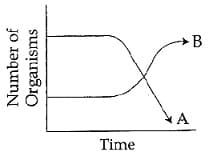When resources are limited, populations exhibit logistic growth. In logistic growth, population expansion decreases as resources become scarce, levelling off when the carrying capacity of the environment is reached, resulting in a __________ curve.
Important Questions on Organisms and Populations
| (a) | Earthworm | (p) | Pioneer species |
| (b) | Succession | (q) | Detrivore |
| (c) | Ecosystem service | (r) | Natality |
| (d) | Population growth | (s) | Pollination |
1) The human liver fluke, a nematode parasite, depends on two intermediate hosts (a snail and a fish) to complete its life cycle.
2) The malarial parasite needs a vector (mosquito) to spread to other host organisms.
3) In case of brood parasitism, the eggs of parasitic birds (e.g., cuckoo) are not detected and removed from the nest because the parasite's eggs resemble the host's eggs in morphology and colour.
4) A population of frogs protected from all predators would decrease indefinitely.

| Column-I | Column-II | ||
|---|---|---|---|
| Saprophyte | Symbiotic association of fungi with plant roots | ||
| Parasite | Decomposition of dead organic materials | ||
| Lichens | Living on living plants | ||
| Mycorrhiza | Symbiotic association of algae and fungi |
Choose the correct answer from the options given below:
If resources are limited
If two species occupy different niches
If resource partitioning takes place between two species
If two species occupy identical niche
In the following equation of Verhulst - Pearl logistic growth, the letter denotes ___ .
The shape of the pyramids reflects the growth status of the population. Identify the type of age pyramid represented below for human population.

Read the following data carefully
| Parameter | Values |
| Initial population of lions | |
| Number of new births in one year | |
| Number of deaths in one year |
Imagine the lion population grows logistically where the carrying capacity is Then the per capita birth rate, per capita death rate, intrinsic rate of natural increase, increase or decrease in population during the unit time period are respectively

